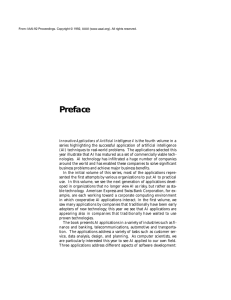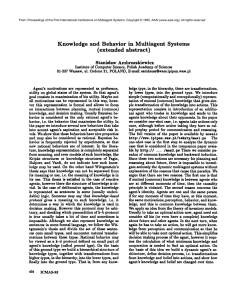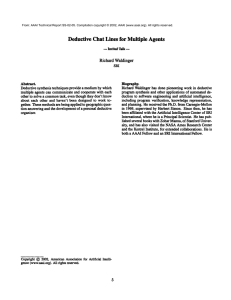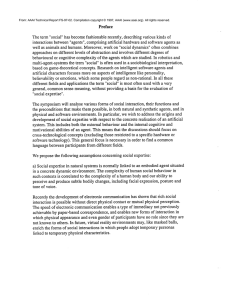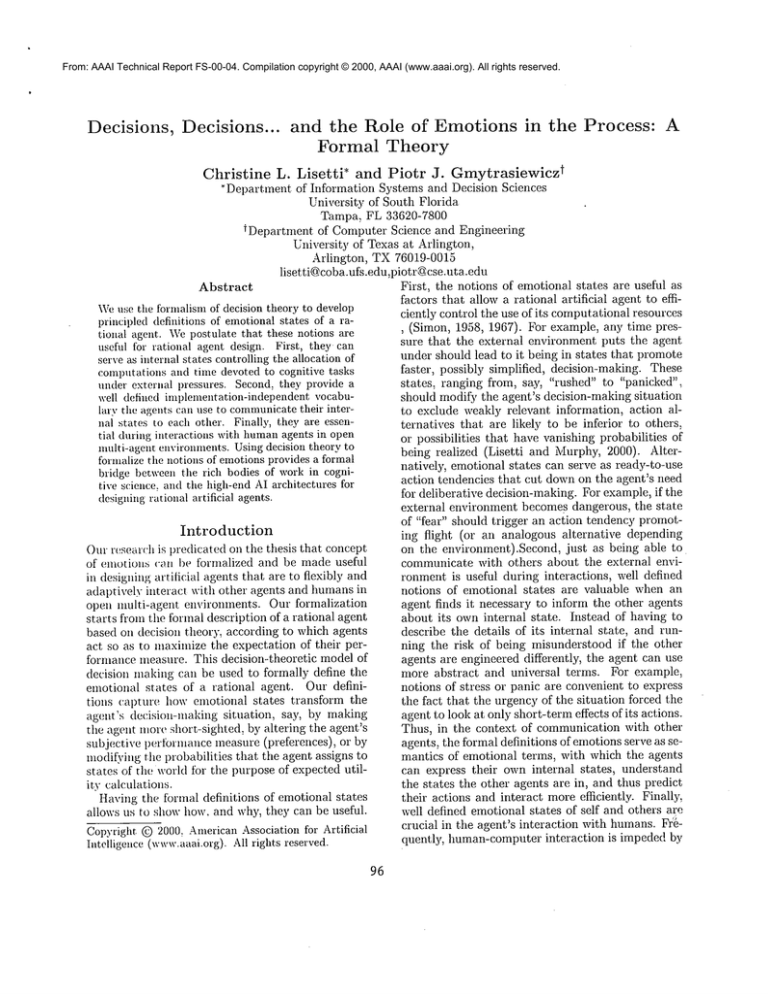
From: AAAI Technical Report FS-00-04. Compilation copyright © 2000, AAAI (www.aaai.org). All rights reserved.
Decisions,
and the Role of Emotions in the Process: A
Formal Theory
tChristine L. Lisetti* and Piotr J. Gmytrasiewicz
Decisions...
~Department of Information Systems and Decision Sciences
University of South Florida
Tampa, FL 33620-7800
tDepartment of Computer Science and Engineering
University of Texas at Arlington,
Arlington, TX 76019-0015
lisetti@coba.ufs.edu,piotr@cse.uta.edu
Abstract
First, the notions of emotional states are useful as
factors that allow a rational artificial agent to effiWeuse the formalisnl of decision theory to develop
ciently control the use of its computational resources
principled definitions of emotionalstates of a ra, (Simon, 1958, 1967). For example, any time prestional agent. Wepostulate that these notions are
sure
that the external environment puts the agent
useflfl for rational agent design. First, they can
under
should lead to it being in states that promote
serve as internal states controlling the allocation of
faster, possibly simplified, decision-making. These
computations and time devoted to cognitive tasks
states, ranging from, say, "rushed" to "panicked",
under external pressures. Second, they provide a
should modi~" the agent’s decision-making situation
well defined implementation-independent vocabuhuy the agents can use to communicatetheir interto exclude weakly relevant information, action alnal states to each other. Finally, they are essenternatives that are likely to be inferior to others,
tial during interactions with humanagents in open
or possibilities that have vanishing probabilities of
nmlti-agent environments. Usingdecision theory to
being realized (Lisetti and Murphy, 2000). Alterformalize the notions of emotionsprovides a formal
natively, emotional states can serve as ready-to-use
bridge between the rich bodies of work in cogniaction tendencies that cut downon the agent’s need
tive science, and the high-end AI m-ehiteetures for
for deliberative decision-making. For example, if the
designingrational artificial agents.
external environment becomes dangerous, the state
of "feat’" should trigger an action tendency promotIntroduction
ing flight (or an analogous alternative depending
on the environment).Second, just as being able to
Our research is predicated on the thesis that concept
communicate with others about the external enviof emotions can be formalized and be made useful
in designing artificial agents that are to flexibly and
ronment is useful during interactions, well defined
adaptively interact with other agents and humansin
notions of emotional states are valuable when an
open nmlti-agent environments. Our formalization
agent finds it necessary to inform the other agents
starts from the tbrmal description of a rational agent
about its own internal state. Instead of having to
based on decision theory: according to which agents
describe the details of its internal state, and running the risk of being misunderstood if the other
act so as to maximizethe expectation of their peragents are engineered differently, the agent can use
formance nteasure. This decision-theoretic model of
more abstract and universal terms. For example,
decision nlaking can be used to formally define the
notions of stress or panic are convenient to express
emotional states of a rational agent. Our definitions capture how elnotional states transform the
the fact that. the urgency of the situation forced the
agent’s decision-making situation, say, by making
agent to look at only short-term effects of its actions.
Thus, in the context, of communication with other
the agent inore short-sighted, by altering the agent’s
subjective pertbrmance measure (preferences), or
agents, the formal definitions of emotionsserve as semantics of emotional terms, with which the agents
modifying the probabilities that the agent assigns to
states of the world ibr the purpose of expected utilcan express their own internal states, understand
ity calculations.
the states the other agents are in, and thus predict
their actions and interact more efficiently. Finally,
Having the tbrmal definitions of emotional states
well defined emotional states of self and others are
allows us to show how. and why, they can be useful.
crucial in the agent’s interaction with humans. F¢fiCopyright @2000, AmericanAssociation for Artificial
quently, human-computer interaction is impeded by
Intelligence (www.aaai.org).All rights reserved.
96
tile machine being hopelessly out-of-step with the
emotional state of the human user. However, the
users’ emotional state, such as anger, fear, boredom,
panic, surprise: joy, or excitation, can be assessed
using measurable and inferred factors (facial expression recognition, vocal intonation, prosody, gah,anic
skin response, heart rate and breathing patterns,
haptic and tactile feedback, body posture ) (Cottrell
1991: Hayes-Roth et al. 1998; (Lisetti and Rumelhart, 1998; Lisetti et al. 1998; Lisetti and Schiano,
2000; Lisetti and Murphy,2000; Lisetti and Bianchi,
2001: Picard, 1997), and predicted from dynamic
emotion models based on observed input events. For
example, it should be possible to predict that an already annoyed human user will not be calmed down
by another system response that is not along the
user’s wishes. Thus. it is important for the machine
to nlodel tile effect the user’s emotional state has on
the user’s decision-making and his/her tendency for
action.
Our al)proach complements and builds on the
existing at)t)roaches to designing rational and socially COml)e~entagents (Bicchieri, 1993; Boutilier
et al., 1999: Cohen and Levesque, 1990; Doyle,
1992; Durfee et al. 1993; Gmytrasiewicz and Durfee,
1995; Kraus and Sycara 1989; Lisetti and Murphy,
2000; Lisetti et al. 1998; Russel 1995; Sycara 1998;
Wooldridge, 1999). Such agents should be able to
flulction efficiently under time and other environnLental t)ressures, and be able to interact and coinnmnicate with other agents. This includes informing
each other about details of the external environment
and about the agents’ owninternal states, as well as
tile abiSlity to nLodeland predict the internal states
of other agents. Apart from the area of multi-agent
systelns, our approach has applications in HumanComputer Interaction (HCI) that range from intelligent tutoring systems and distance learning support systems (with recognition of expressions signaling interest, boredom, confusion), to stress and
lie detectors, to inonitors of pilots and drivers’ state
of alertness, to software product support systems
(with recognition of users being dis/pleased with
softwme products), to entertainment and computer
games (enjoyment. confusion), to ubiquitous computing am! smart houses (Mozer, 1998).
Using Decision-Theoretic
the Decision-Making
hand (Boutilier et al., 1999; Dennet, 1986; Doyle,
1992; Russel, 1995; Simon, 1958; Wooldridge, 1999),
with research on humanemotions in cognitive science and psychology on the other hand (Damasio,
1994; James 1894; Johnson-Laird and Oatley, 1992;
Leventhal and Scherer, 1987; Ortony, 1988; Simon,
1967; Sloman, 1981; 1990).
Weuse decision-theoretic paradigm of rationality,
according to which rational agent should behave so
as to maximizethe expected utility of its actions (see
(Boutilier et al., 1999; Doyle, 1992; l~ussell, 1995)
and references therein). The expected utilities of the
alternative courses of action are computedbased on
their possible consequences, the desirability of these
consequences to the agent, L and the probabilities
with which these consequences are thought by the
agent to obtain. The main thrust of our work is to
examine ways in which components of the decisiontheoretic model, i.e., the utility functions, the set
of behavioral alternatives, and the probabilities of
consequences, can be transformed in ways that has
been recognized in cognitive science as interactions
between emotional states and decision-making.
A rational agent formulates its decision making
situation in terms of a finite set, A, of the alternative courses of action, or behaviors, it can execute,
which we will call the agent’s action space. An alternative behavior, say ai, is a plan consisting of
consecutive actions extending into the future time
t~, which we will call the time horizon of this particular plan. Alternative courses of action in set A
can stand for abstract actions as well as for detailed
elaborations; increasing the level of abstraction facilitates keeping the size of A down to manageable
proportions. We demand that the actions be distinct and that the set A be exhaustive, i.e., that all
of the possible behaviors be accounted for. Sometimes an ’:all-else" behavioral alternative is used for
compactness, and represents all other possible behaviors except the ones explicitly enumerated.
At any point, an agent finds itself in some state
of the world, but due to the fact that the environment may not be fully observable the agent may be
uncertain about the state. The fact that the actual
state may be unknownto the agent can be formalized by specifying the set of all possible states of
the world, S, together with a family of probability distributions,
P(S), over these states. One
these distributions, say P~(S)(c P), specifies which
of these states are currently possible and howlikely
they are. Thus P~(S) fully describes the information
the agent has about the present state of the world.
The agent can ponder the consequences of its alternative actions. Due to possible nondeterminism
to Describe
Process
The objective of our research is to develop a fundanlental understanding of the role and useflllness
of the concept of" emotional states in designing intelligent artificial
systems. Our approach draws on
and combines an emerging technology of rational
agent design of Artificial Intelligence on the one
~Suchagents m-esometimescalled self-interested.
97
each action. (ti E .4. may lead to many resulting
possible states. The likelihoods of the resulting
states can be specified by another probability distribution.
P~(S)(c P), also over S. The process
of determining the probabilities of different results,
i.e., the distribution Pi has been called a probabilistic temporal projection. The projection is a function Proj : P(S) x A ~ P(S); the result of
jetting the results of action ai given the current information about the state P~(S) results in the projected intbrmation about the resulting state, Pi(S):
Proj(P,.(S).ai)
= Pi(S). The above formulation
does not t)reclude that the state change due to actions of other agents or exogenousevents; here these
effects are implicit and folded into the projection
function (Boutilier. 1999).
The desirabilities of the states of the world to the
agent are encoded using a utility function U : S --~
R, which maps states of the world to real numbers.
Intuitively, the higher the utility value of a state the
more desirable this state is to the agent. The agent
decision problem involves choosing which of the alternative actions in the set A it should execute. One
of the central theorems of decision theory states that
if the agent’s utility function is properly formed, and
the agent expresses its uncertain beliefs using probabilities, then the agent should execute an action, a*,
that maximizesthe expected utility of the result.
(i)
=
sES
where the 1)~ in the probability the projected distribution Pi(S) assigns to a state sJ E S. Frequently, it
is conveuient to represent the utility function, U, as
depending on a small number of attributes of the
states of the world, as opposed to depending on
the states themselves. This is intuitive; some humansmayprefer, say, all of the states in which they
have more money, are more famous. The attributes,
say wealth, and fame are then convenient factors in
terms of which the utility function can be expressed.
The formalism can also be used to model agent
whovalue inner state quality versus material quantits’, such as feeling loved, well-being, and healthy.
In this case, the attributes are then subjective attributes based on the actual states of feeling loved,
and healthy. Multi-attribute utility theory postulates that, in somesimple cases, the utility of a state
is a weighted sum of the utilities, U(Xt(s)) of individual attril)utes:
=
(2)
Xt c.4tt r ibutes
where the |l’x, is the weight, or intuitively, the importance, of the attribute Xt. Having the weights
98
of the attributes explicitly represented is convenient
since it enables the tradeoffs amongthe attributes
the agent may have to make. For example, the agent
may have to give up give up some of its health to
improve its fame. Alternatively, another agent may
need to be willing to experience some temporary
guilt (temporary violation of standard set for oneself) to enhance its overall long-lasting happiness,
and so on.
The elements defined above are sufficient to formally define a decision-making situation of an agent:
Definition 1: A decision-making situation of an
agent is a quadruple: D =< P~(S), A, P.roj, U
where S, Pc(S), A, Proj and U are as defined above.
The above quadruple fully specifies the agent’s
knowledge about the environment, the agent’s assessment as to its possible courses of action, the possible results of the actions: and desirability of these
results. Our definition here is closely related to that
of stochastic processes, and in particular to Markov
decision process (see (Boutilier, 1999; Russell, 1995)
and references therein), but it makesexplicit the decision problem the agent is facing by enumerating
the alternative action sequences the agent is choosing among.
Given its decision-making situation, an agent can
computeits best action, a*, as specified in Equation
1. It is clear that this computation can be fairly
complex. In a multi-agent environment, for example, all of the information the agent has about the
physical environment and about the other agents
could be relevant and impact ghe expected utilities of alternative courses of action. Sometimesthe
agent may have information about the other agents’
state of knowledge, which is also potentially relevant. Given these complexities it is clear that a
mechanism for managing the agent’s computational
resources is needed. Here, we suggest that emotional
states, as defined below, mayprovide for such ability.
Classifying Emotional States
their Dynamics
and
As we mentioned, we will view emotions as transformations of the decision-making situation defined
above. First, we briefly describe a taxonomyof emotional states and a finite state machinemodelof dynamics of emotions which can assist agents in measuring and predicting the emotional state of other
agents.
The taxonomy (Lisetti, 1997, 2001) of emotional
states in Figure 1 is aimed at differentiating among
emotional states by using values of well-defined attributes. It is clearly desirable to be able to measure
the values of the attributes to be able to determine
Figure 2: Simple Dynamic- Model of an Agent’s
Emotional States
Figure
States
1: An Example Taxonomy of Emotional
the curren~ emotional state of another agent. Given
the emotional state, its impact on decision-making
can be modeled. Presently, only some of the attributes differentiating various emotional states are
directly measurable: in humanagents for example,
the positive and negative values of valence attribute
may be measurable from facial expression recognition tools. Further, the taxonomy is incomplete in
that we (and our colleagues in cognitive science)
do not yet know what attributes and their values
should be used to differentiate
among some emotional states tbr artificial agents.
Our framework also uses a dynamic model of
user’s emotional states. Its purpose is twofold: First
it is frequently ,seful not only to assess the current
emotionalsta~ e the other agent is in but also to predict what emotional state will obtain, given the current emotion on one hand, and a system’s response
or environmental event on the other hand. Second,
since some of the variables that determine the current emotional state are not measurable, it may be
possible to infer the current state from the previous
state, if known, and the environmental input. In
Figure 2 we present a very simple example model of
emotions: dynamics. It contains only three emotional
states:
COOPERATIVE,SLIGHTLY ANNOYED,and ANGRY.The transitions
among the
states are caused by environmental inputs or responses of the system, and they are divided into
categories of Cooperative and Uncooperative. Using
this dynamic model one can predict that an agent
that is in COOPERATIVE
emotional state will become SLIGHTLYANNOYED
given Uncooperative
input. Further, the emotional state of SLIGHTLY
ANNOYED
will evolve into ANGRY
if another Un99
cooperative response follows.
Dynamicmodels that use the formalism of finite
state automata like the one in Figure 2 are common
and used in the field of game theory. The simple
example we presen~ here coincides with the Tit-fortwo-Tat strategy used for the Prisoner’s Dilemma
game (Axelrod, 1984; Carmel, 1996; Rubinstein,
1986). The advantage of modeling emotional states
of the user with the finite automata model is that
models of this kind can be learned, for exampleusing
an unsupervised US-L learning algorithm (Carmel,
1996; Littman, 1994; Sandholm 1995).
Defining
Emotions
Decision-Theoretic
with
Wenow outline some classes of transformations of
the decision-making situation of an agent. Wecall
them emotional transformations, and their results
are emotional states. In other words, an emotional
transformation changes one decision-making situation, say a NEUTRAL
emotional state, into another one, say an ANGRYemotional state.
We
assume that the emotional transformations themselves are triggered by some environmental input,
IN, the agent experiences. Weshould caution that
our identi%,ing emotions with such transformations
does not account for all of the richness of emotions
in humans; in fact our decision-theoretic approach
limits our formalization to emotions that impact the
agent’s decision making - the emotions that do not
have such impact clearly cannot be accounted for.
Let us denote as D the set of all decision situations, D, as defined by Definition 1; with the caveat
above, we postulate that each D ~ D correspond to
an emotional state. Further, let IN be the set of all
environmental inputs.
Definition 2: Emotional transformation
is a
function EmotTrans : D × IN* --+ D.
Thus, given an initial emotional state, D, and
a, possibly empty, history of environmental inputs IN, the value of the EmotTrans function is
ErnotTrans(D, IN) = D’, where D’ is the agent’s
new emotional state. Examples of such emotional
the weights of the factors contributing to the utility
ratings (Equation 2).
Formally,
these are transformations EmotTrans(D, IN) =
such that D =< P~(S), A, Proj, U >, and D’ =<
Pc(S), A, Proj, U’ >.
The special case of sadness or melancholy result
in evaluation of the desirability of every state to diminish: Vs E S: U’(s) <_ U(s).
transformations are depicted in Figure 2. D’ may
differ fi’om D in a Immber of ways. Below we look
at somepossibilities that correspond to some of the "
more intuitive emotional states.
Transformations
of the action space A
Transformation of the action space A, for example
by narrowing the set of alternative actions considered to encomI)ass only a small subset" of all of the
actions, predisl)oses the agent to take action from
this smaller set. This constitutes the action tendency that the emotion is invoking in the agent, as
postulated, for example, by Frijda in (Frijda, 1986).
In the extreme, narrowing the set A to a single
action implements a behavioral condition-response
rule.
Formally.
these are transibrmations EmotTrans(D, IN) = ~
such that D =< P~(S),A, Proj, >, and D’ = <
P,.(S), .4’. Proj, U >. An emotional transformation
that implements an action tendency is one for which
.4’ C .4. For example, an agent becoming angry
mayresult in it considering only a subset of its behavioral alternatives, say, ones of aggressive nature.
A special case of this emotional transformation obtains whenA’ is a singleton set, containing only one
behavior. This is an implementation of a emotional
condition-action rule; all three emotional states that
correspond to the Tit-for-two-Tats strategy in repeated Prisoner’s Dilemmagame in Figure 2 are of
this kind since they result in the agent’s being capable of perlorming only a single behax, ior.
Another intuitive special case of such transformation is one that results in the agent’s deliberating in
a more short-term fashion, such as it being rushed
or panicked under time pressure. Formally we have:
Va’i E A’ : tj <_to,, whichstates that the time horizon of alternative plans considered has diminished.
This is characteristic
of truman decision-makers;
people frequently become more short-sighted when
they are rushed or panicked, since they have no time
to consider long-term effects of their alternative behaviors.
Transformations
of the probabilities
of
states
The intuition behind this transformation is that
changing these probabilities, for instance by simplifying them, can be helpful and save time under time
pressure. The most radical simplification is one that.
makes the most. likely state to be the only possible state or result. This corresponds to considering
only the most likely result of action and neglecting
all less likely states and is often observed in human
decision-makers.
Formally,
these
are
transformations EmotTrans(D, IN) = D’ such that D =<
Pc(S),A, Proj, U >, D’ =< P~(S),A, Proj’,U
The special case described above obtains is when
the probability distribution P~, as well as every projected distribution Pi returned by the projection
function Proj’ are deterministic.
Conclusions
and Future
Work
This paper outlined an approach to formally defining the notions of emotions of rational agents. Following one of the recent approaches to designing
rational agents based on decision theory (Russel,
1995), we attempted to define emotional transformations, and the resulting emotional states, as resulting from input the agents receive from the environment. The emotional states are identified as
possible modifications of the decision-making situations the agents find themselves in.
Our approach is one way to formally bridge a gap
between research on emotions in cognitive science,
and the formal approaches to rational agent design
in AI. Well-defined notion of emotional states is useful for intelligent systems that are to operate under
time pressure, in multi-agent environments. First,
emotions can serve as control mechanisms that allow agents to managetheir computational resources
while deliberating about action under time pressure.
Second, well defined notions of emotions serve as
vocabulary that the agents can use to describe their
internal states to each other without referring to implementational details. Finally, these notions are
critical when the agents are to effectively interact
with humans.
Transformations
of the utility
functions
U
Intuition behind this transformation is that emotions and feelings both implement U, as well as
inodit)" it. Humansevaluate desirability of states
by having positive or negative feelings about them.
Positive or negative emotions or moods may alter
these evaluations by, say, decreasing them, as in
melancholic or depressed moods (when everything
looks bleak); or increasing them, as in elated or
hat)py moods. Other emotional states can change
i00
The approachwe outlined serves as a point of departure for nntch of the needed future work. The
definitions of emotionaltransformationscan be elaborated upon. and moreintuitive special cases can be
anive(l at. These cases should ultimately find their
way itlto the taxonolny depicted in Figure 1, and be
defined ill terms of measurableattributes (Ortony,
1988). Fl?.rther. the dynamicmodels of emotional
states, like the one in Figure 2, can become far
moreelaborate, thus allowing the agents to predict
the emotional states of other agents and humansin
nmchmore detail.
C.L. Lisetti
and R. Murphy. Emotional
V, raiters.
In AAAI National Conference on Artificial
Intelligence
Mobile Robot Competition
http:~.czoo.usf.odu/robotlcs/Compatitions.
Menlo Park, CA: AAAI
Press, 2000.
C.L. Lisetti
and D. Rumelhart.
Facial expression
recognition
using
a neural network. In D. Cook, editor,
Proceedings
of the 1998 International Florida Artificial
Intelhgence
Research Symposium Conference
(FLAIRS’98),
pages 328-332.
Menlo Park, CA: AAAI Press,
1998.
C.L. Lisetti
and D.J. Schiano. Automatic Facial Expression
Interpretation:
Where Human-Computer Interaction,
Artificial
Intelligence,
andCognitive
Science Intersect.
Pragmatics and Cognition (Special Issue on Facial Information Processing: A z~4ultidisciplinary
Perspective,
8(1):185-235,
2000.
M. L. Littman.
Markov Games as Framework
for Multi-Agent
Reinforcement
Learning.
In prom of the International
Oonference
on
¯ ~lachine Learning, 1994.
M. Mozer. The neural
network house: An environment
that adapts to
its inhabitants.
In IVorking notes of the 1998 AAAI Spring Symposium
Series on Intelligent
Environments,
pages 110-114. AAAI Press, 1998.
References
R. Axeh’od. The Et.oh,
(’. Bicchieri.
Press. 1993.
tion
of Cooperation.
Rat,)nality
A. Ortony, G. Clore, and A. Collins.
tions.
Cambridge University
Press,
Basic Books. 1984.
and Coordination.
Cambridge
University
P. 11. Cohen and 11. J. Levesque. Rational Interaction
Communication.
In Intentions
in Communication.
MIT Press. 1990.
Agents.
1996.
T. Sandholm
and Iterated
1995.
as the Basis for
Cambridge,
MA:
Descartes’
Error.
1). l)ennett.
Intentional
MIT Press.
1986
Avon Books,
Systems.
.] Doyle Rationality
and its
;,:lh,Jetl,:~.
~:376-40.~1. 1992.
H Simon.
chological
Role in Reasoning.
Cambridge,
Computational
MA:
Frijda
Th~ Emotwns.
ln-
K. Sycara.
New York:
Cambridge
University
P. Gmytrasiewicz
and E. Durfee. A Rigorous,
Operational
tion of Recursive .Modeling. In Proc. of the International
on ,’,lultielgent
Systems. pages 125-132, 1995.
x.V. James. "l’hc
1:516- 529. 189.t.
Physical
.’.find.
Basis
9:188-205,
of Emotion.
Press,
FormalizaConference
1884.
Psychological
Review,
P. Johnson-l.aird
and 14.. Oatley’.
Basic Emotions, Rationality,
Folk Theory. (’agnztwn and Emotion, 6(3/4):201
223, 1992.
S. Kraus and K. gycara.
Argumentation
real Model and hnplementation.
Artificial
1989.
It. Leventhal
and K. Scherer.
nition:
A Functional
Approach
and Emotion. 1(11:3-28.
1987.
and
in Negotiation:
A ForIntelligence,
104(1-2):1-69,
The Relationship
of Einotion
to Cogto a Semantic Controversy.
Cognition
C. L. Lisetti.
D. E. Rumelhart,
and M. Holler.
An Environment
to
Acknowledge the Interface
between Affect and Cognition.
In AAAI
Sprang Sytapo~u,m Strzes on Intelligent
Ent, ironments (AAAI SSS-98).
A/so Technical Eel,oft
SS-98-OP..
Menlo Park. CA: AAAI Press, 1998.
C.L. Lisetti.
Motives for intelligent
agents: Computational scripts for
emotion concept~-. In G. (31"ahne. editor, Proceedings of the Sizth Scandlrl.lt’ttJn
(~o,lfcr~:n¢ t on Artificial
Intelligence (SCAI’g7), pages 59 70.
Amsterdam. llolland:
lOS Press, 1997.
(’.L.
Li~etti.
mitted.
t’omputationai
Schemata
for
Emotion
Ontology.
C.L.l.isettl
and N. Bianehi-Berthouze.
Toward Affective
Modeling Subjective
Emotional Experience.
Submitted.
MultiAgent
Systems.
AI Magazine,
M. D,:ooldridge
and A. Rag. Foundations
Academic Publishing,
1999.
B. Hayes-Itoth.
G. Ball. C. Lisetti,
and A. Picard, R.and Stern. Panel
on Affect and Emotion in the User Interface.
In Proceedings
of the
1998 lntemzatJonal
Conference on Intelligent
User Interfaces
(IUI’98),
pages 91 -94. New York. NY: ACMPress,
1998.
\V. James. IA’hat is an Emotioia?
Controls
Cam-
of Cognition.
P~y-
A. Sloman and M. Croucher.
Why robots
will have emotions.
Proceedings
of the Seventh IJCAI Vancouver, B.C., pages 197-202.
Marco, CA: Morgan-Kaufmann,
1981.
E. Durfce..I
Lee. and P. Gmytrasiewicz.
Overeager
Rationality
and
Mixed >;trato~4y F.quilihlia.
In Proc. of the National Conference on
..ttt~tieaal
[ntelhdencc. 1993.
N. It.
1986.
Motivational
and Emotional
Review, 1:29-39, 1967.
of the Environment.
A. Sloman. Motives,
Mechanisms,
and Emotions.
In M. Boden, editor, The Philosophy of Artificial
Intelligence.
Oxford: Oxford University Press, 1990.
1994.
In Brainstorms.
of Emo-
and R. H. Crites.
Multiagent
Reinforcement
Learning
Prisonner’s
Dilemma. Biosgsteras
Journal,
37:147-166,
H. Simon. Rational Choice and the Structure
bridge,
MA: MIT Press,
1958.
G. Cottrell
and J. Metcalfe.
EMPATH: Face, emotion,
and gender
recognition
using holons.
In R.P. Lippman,
J. Moody, and D.S.
Touretzky.
editors.
Adt’ances
in Neural Information
Processing
Systems. pages 564 571. Morgan Kaufmann Publishers,
1991.
A. Damasio.
Struett:re
R. V/. Picard.
Affective
Computing.
Cambridge,
MA: M.I.T. Press,
1997.
A. Rubinstein.
Finite
Automata
Play the Repeated
Prisonner’s
Dilemma. Journal o I Economic Theory, 39:83-96,
1986.
S. Russell and P. Norvig. Artificial
Intelligence:
A ).[odern Approach.
New Jersey:
Prentice
Hall, 1995.
T. Boutilicr.
(’. Dean and S. Hanks. Decision-Theoretic
Planning:
Structural
Assumptions and Computational
Leverage.
Journal of Artificial
Intelhg--nc¢
Research. ll:l 94. 1999.
D. Carmel and .’:,.
Markovitch. Learning Models of Intelligent
In Pro,:. of th~ National Conference on Artsficial
Intelligence,
The Cognitive
1988.
Sub-
Computing:
i01
10(2):79-93,
of Rational
Agency.
In
San
1998.
Kluwer


